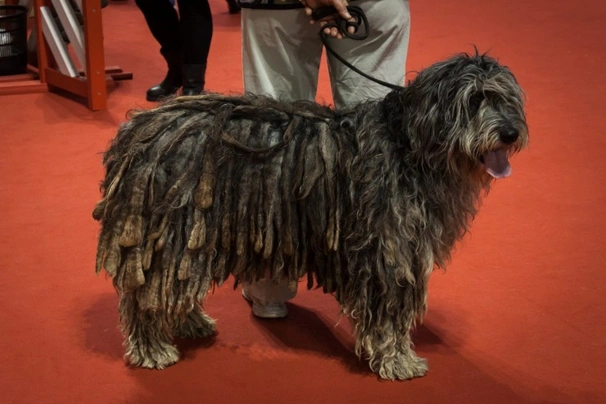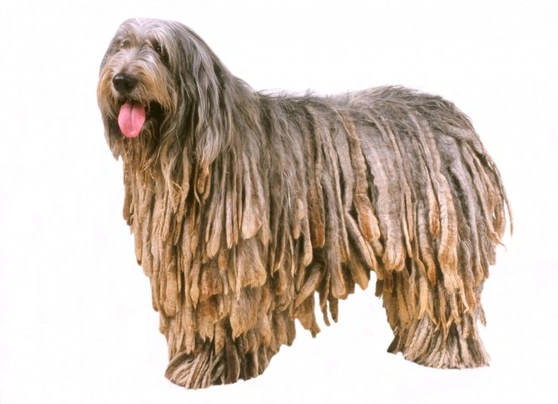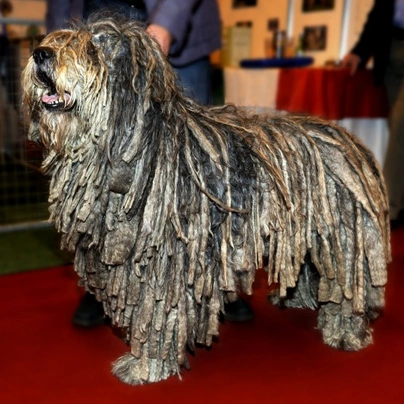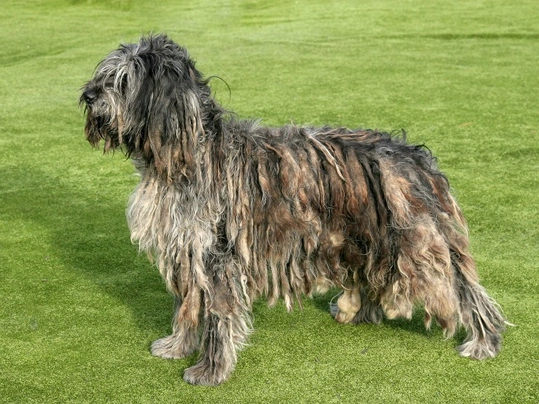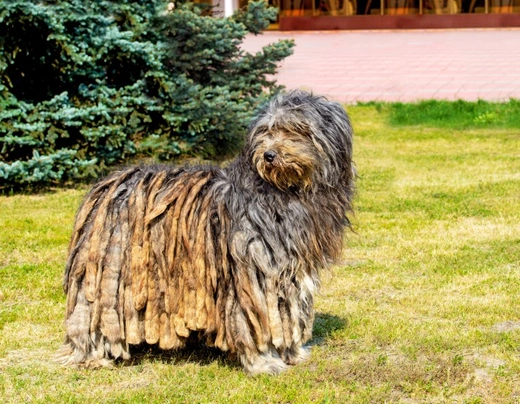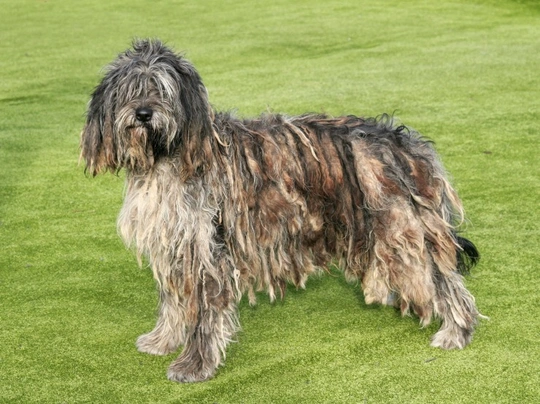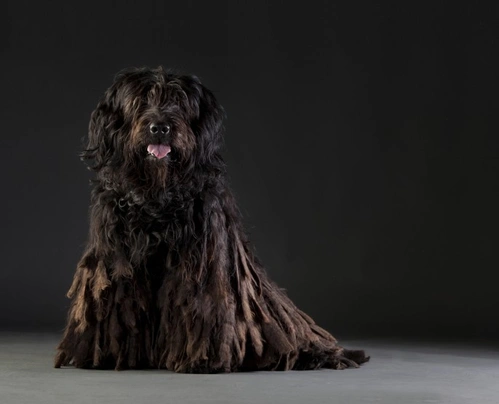Bergamasco
Pros
Cons
Introduction of the Bergamasco
The Bergamasco is native to northern Italy where they were originally bred to herd and guard livestock a job they are highly skilled at doing. The Bergamasco is a distinct looking dog with an extraordinary coat that forms loose mats and cords all of which hang down from a dog's topline.
They are powerful looking dogs and they are not the ideal choice for first time owners because they need to be well trained and handled correctly from a young age to be truly well-rounded confident dogs but even then they are known to be quite cautious characters by nature. However for people who are familiar with this type of dog and who spend lots of time in the great outdoors the Bergamasco would be a perfect pet and companion dog.
History of the Bergamasco
The Bergamasco is an ancient breed that can trace it’s history back 7000 years to Persia which today is known as Iran. They were bred to protect and herd flocks of livestock in some of the most challenging harsh terrains spreading from Persia to Europe with their nomad owners. Some tribes reached as far as the Italian Alps where they set down their roots and kept their dogs with them which were to become known as the Bergamasco.
In their native Italy the Bergamasco was highly prized by shepherds for their herding and guarding abilities. The breed can trace its origins back seven thousand years to a country that is now known as Iran. Shepherds formed strong bonds with their dogs and they worked closely together on a one-to-one basis in challenging climates and mountainous terrains. Unlike other shepherding dogs the Bergamasco was bred to be an independent thinker which in short meant they were more than capable of working flocks on their own without the need of being given commands from their shepherds. These dogs are real problem solvers and quite independent characters which is why they need to be trained and given the right direction from a young age and then throughout their lives.
Shepherds wanted to develop a robust dog and the result is an extremely distinctive looking working dog that boasts a felted coat. The dense cords offer these dogs a tremendous amount of protection from the elements but they also offered a lot of protection from attacks from bears wolves and other predators that attacked livestock these dogs were herding and guarding.
For many years the breed was protected by local shepherds which meant that bloodlines remained pure. However as time passed and with the demise of sheepherding in northern Italy shepherds and breeders started selling dogs to people outside of the country who were more than eager to own one of these magnificent and curious looking characters.
The Bergamasco was crossed with other herding dogs and this led to a decline in the number of "true" bloodlines which resulted in the breed almost vanishing off the face of the earth. Luckily enthusiasts of the breed in their native Italy pulled the Bergamasco back from the brink of extinction and over the years the number of extraordinary dogs has risen not only in Italy but in other countries of the world including here in the UK.
Interesting facts about the breed
- Is the Bergamasco a vulnerable breed? No although quite rarely seen in the UK and well-bred puppies can command a lot of money with waiting lists being long
- The Bergamasco can trace it’s history back 7000 years to a country that is now known as Iran
- The breed was popular with Dr Andreoli who bred Bergamascos for around 40 years in Italy
- The breed’s correct name is “Pastore de Bergamasco”
- Bergamascos are never called Bergies or Bergs
- Their coats develop into flat flocks naturally and are never twisted cords
- It can take 8 hours for a Bergamasco’s coat to dry once wet
- Their coats offer them great protection against the cold but they also act as brilliant insulation when the weather is hot too
- Once a Bergamasco’s coat is “set” they are easy maintenance
- A Bergamasco’s coat should not be “brushed out” once their flocks are set
Appearance of the Bergamasco
Height at the withers: Males 60 cm Females 56 cm at the withers
Average weight: Males 32 - 38 kg Females 26 - 32 kg
Bergamascos are medium sized dogs that boast a powerful compact look about them. Their most distinguishing trait being their superbly dense matted coats. Their heads are well proportioned with muzzles being the same length as a dog's broad skull which is slightly convex between their ears. However their foreheads are nicely rounded and their ears are set high on a dog's head.
Their nose tapers to the tip without being pointed and they boast a very strong under jaw with nicely pigmented lips. A Bergamasco's eyes are oval in shape and a nice dark chestnut colour. However the colour of a dog's eyes depends on their coat colour. These dogs have a very calm look about their eyes but they also give the impression of being extremely attentive. Their eyes are black rimmed with distinctive long eyelashes.
As previously mentioned their ears are set high on a dog's head and they drop down over their brow. However when excited and alert the Bergamasco holds their ears upright. Ears are triangular in shape and wider at the base with tips being slightly rounded and they are covered in slightly wavy soft hair which forms a fringe at the very tip.
The Bergamasco has a perfect scissor bite and their lips are well-split. Necks are strong and well-arched being medium in length and covered in dense matts. Their shoulders are well angled and laid well back and these dogs boasts straight powerful front legs. Their body is compact and well-defined with a well sprung rib cage and nice straight topline with a slightly sloping croup.
Their hindquarters are powerful and these dogs have well-muscled upper thighs and strong back legs. Feet are oval in shape with closed well arched toes with pigmented nails and their paw pads are dark in colour. Their tails are strong and thicker at the root tapering to the tip. Dogs hold their tails slightly curved and upright when they are working or alert but never over their backs.
When it comes to a Bergamasco's coat there is a lot of it with long mats that fall loosely from a dog's topline down their flanks which are hard in texture on their forequarters yet softer on a dog's legs and head. They have a shorter and denser undercoat and a Bergamasco's coat is greasy to the touch which is perfectly normal. The accepted coat colours for Kennel Club registration are as follows:
- Black
- Fawn
- Grey
- Isabella
Dogs are allowed to have white patches on their bodies but these must not cover more than a fifth of their total coat colour.
It is worth noting that the accepted breed colours for Kennel Club registration can differ from those set out in the breed standard which are as follows:
- Solid grey with patches of varying shades of grey through to black
- Black
- Isabella
- Light fawn
A Bergamasco can have white patches in their coats providing it is not more than one fifth of it.
Gait/movement
When a Bergamasco moves they take long free striding steps with dogs being capable of maintaining a fast free-moving gallop.
Faults
The Kennel Club frowns on any exaggerations or departures from the breed standard and would judge the faults on how much they affect a dog's overall health and wellbeing as well as their ability to perform.
Males should have both testicles fully descended into their scrotums and it is worth noting that a dog can be a little lighter or heavier as well as slightly taller or shorter than set out in the Kennel Club breed standard which is only given as a guideline.
Temperament of the Bergamasco
The Bergamasco is essentially a working dog and therefore they are always vigilant alert and protective by nature. They are definitely not the best choice of dog for a first-time owner because they need the right sort of socialisation training and handling from a very young age or these dogs may become too much of a handful.
They are highly intelligent dogs that boast a cautious side to their natures. They are very patient which is why they are so highly prized as shepherding dogs. With this said they were bred to be "independent" thinkers which in short means they do not need to be told what to do when they are working. This trait is deeply embedded in the breed which is why a Bergamasco needs to be kept busy and given lots of physical exercise and mental stimulation for them to be truly happy well-rounded relaxed dogs.
These dogs have incredible hearing which means they are quick to alert owners if anyone or anything is approaching their territory. This is another trait that is deeply embedded in their nature. They tend to be quite wary of strangers and people they have never seen or met before which is another trait deeply embedded in their natures.
Are they a good choice for first time owners?
A Bergamasco is not the best choice for first time dog owners unless they have the time to dedicate to such an intelligent high-energy dog and one that thrives on human company and that needs to the right kind of handling socialisation and training right from the word go. They are particularly good with young children and older people too although playtime can get a bit boisterous at times.
What about prey drive?
Having been bred to protect flocks of livestock a Bergamasco has a high prey drive even in a home environment and will happily chase anything that tries to run away from them or that they spot in the distance. As such care must always be taken as to where and when a dog can run off the lead more especially if there is wildlife or livestock close by.
What about playfulness?
Bergamascos have a very playful side to their natures and love to entertain and be entertained. They are known to be a little mischievous when the mood takes them and being so clever they quickly understand how to please an owner and how to get their own way. They adore playing interactive games with children which is something they love to do.
What about adaptability?
Bergamascos are better suited to households with well-fenced secure back gardens that a dog can safely roam in whenever possible to really let off steam. As such they are not the best choice for anyone who lives in an apartment in town.
What about separation anxiety?
Bergamascos form strong ties with their families and dogs are never very happy when they find themselves left on their own for longer periods of time. They are better suited to people who either work from home or in households where one person stays at home when everyone else is out so they are never alone for any length of time which could see a dog suffering from separation anxiety. This can lead to them being destructive around the home which is a dog's way of relieving any stress they are feeling and a way to keep themselves entertained.
What about excessive barking?
Some Bergamascos like the sound of their own voices but in general they are not known to be “barkers” and will only bark when they think it is necessary which makes them such good watchdogs bearing in mind that they are very alert to everything that goes on in their surroundings.
Do Bergamascos like water?
Most Bergamascos like getting their feet wet and will take to the water whenever they can more especially when the weather is hot. However if anyone who owns a dog that does not like water should never force them to go in because it would just end up scaring them. With this said care should always be taken when walking a Bergamasco off the lead anywhere near more dangerous watercourses just in case a dog decides to leap in and then needs rescuing because they cannot get out of the water on their own. It is also very important to thoroughly dry off a dog’s coat after they have been in the water which can takes hours but it prevents any moisture from being trapped in their coats which could lead to a skin flare up.
Are Bergamascos good watchdogs?
Bergamascos are great watchdogs which is a trait that is deeply embedded in a dog’s psyche having been bred to protect large flocks in their native Italy for centuries. However rarely would a dog show any sort of aggressive behaviour towards anyone unless they feel threatened in any way.
Intelligence / Trainability of the Bergamasco
The Bergamasco is an intelligent dog and although they have an independent side to their nature in the right hands they are easy to train. The key to successfully training one of these dogs is to start their education early and to always be consistent fair yet firm.
Puppies must be well socialised from a young age for them to be truly well rounded obedient dogs later in their lives. Without all the right sort of contact with other dogs animals and different situations a Bergamasco might become wilful and unruly making them harder to handle.
Like all puppies Bergamascos are incredibly cute when young and it is all too easy to spoil them when they first arrive in new homes. As soon as a puppy is nicely settled owners must start out as they mean to go on by laying down ground rules and boundaries so that a puppy understands what is expected of them. It helps establish a pecking order and who the alpha dog is in the household. The first commands a puppy should be taught are as follows:
- Come
- Sit
- Stay
- Heel
- Quiet
- Leave it
- Down
- Bed
Children and other
Bergamascos are known to be lively intelligent and friendly dogs that boast a natural desire to protect. They form extremely strong bonds with their owners and members of a family. In general they are also known to be tolerant of children although adult supervision is always advisable when dogs interact with the kids to make sure things stay nice and calm.
If a Bergamasco grows up with other pets in a household they are generally quite tolerant when they are around them. However if they have never met a cat or other small pet before it is best to avoid leaving them alone together.
Health of the Bergamasco
The average life expectancy of a Bergamasco is between 13 - 15 years when properly cared for and fed an appropriate good quality diet to suit their ages.
These dogs are known to be robust and healthy characters but it's important to contact a reputable well established breeder if you are thinking about getting a Bergamasco puppy because they would have done their utmost to breed healthy puppies and dogs. Although they have heavy flock coats and should not be exercised in very hot weather their coats not only protect them from the cold but they keep them cool when it’s hot too. The health issues that appear to affect the breed the most are as follows:
- Hip dysplasia– dogs should be hip scored by a BVA registered vet or through the Animal Health Trust (AHT)
- Eye issues
- Obesity
- Bloat/gastric torsion
What about vaccinations?
Bergamasco puppies would have been given their initial vaccinations before being sold but it is up to their new owners to make sure they have their follow-up shots in a timely manner with the vaccination schedule for puppies being as follows:
- 10 -12 weeks old bearing in mind that a puppy would not have full protection straight away but would be fully protected 2 weeks after they have had their second vaccination
There has been a lot of discussion about the need for dogs to have boosters. As such it's best to talk to a vet before making a final decision on whether a dog should continue to have annual vaccinations which are known as boosters.
What about spaying and neutering?
A lot of vets these days recommend waiting until dogs are slightly older before spaying and neutering them which means they are more mature before undergoing the procedures. As such they advise neutering males and spaying females when they are between the ages of 6 to 9 months old and sometimes even when a dog is 12 months old.
Other vets recommend spaying and neutering dogs when they are 6 months old but never any earlier unless for medical reasons. With this said many breeds are different and it is always advisable to discuss things with a vet and then follow their advice on when a dog should be spayed or neutered.
What about obesity problems?
As with other breeds some Bergamascos gain weight after they have been spayed or neutered and it's important to keep an eye on a dog's waistline just in case they do. If a dog starts to put on weight it's important to adjust their daily calorie intake and to up the amount of exercise they are given. Older dogs too are more prone to gaining weight and again it's essential they be fed and exercised accordingly because obesity can shorten a dog's life by several years. The reason being that it puts a lot of extra strain on a dog's internal organs including the heart which could prove fatal.
What about allergies?
Some Bergamascos are prone to suffering from allergies because moisture can all too easily get trapped in between their flocks and their skin if they are dried off correctly and thoroughly when they get wet or after they have been bathed. It's important for a dog to see a vet sooner rather than later if one flares up. Allergies can be notoriously hard to clear up and finding the triggers can be challenging if it is not due to moisture being trapped in their coats. With this said a vet would be able to make a dog with an allergy more comfortable while they try to find out the triggers which could include the following:
- Certain dog foods that contain high levels of grains and other cereal-type fillers
- Airborne pollens
- Dust mites
- Environment
- Flea and tick bites
- Chemicals found in everyday household cleaning products
Participating in health schemes
All responsible Bergamasco breeders would ensure that their stud dogs are tested for known hereditary and congenital health issues known to affect the breed by using the following scheme:
- Hip scoringby a BVA registered vet or through the Animal Health Trust (AHT)
What about breed specific breeding restrictions?
Apart from the standard breeding restrictions that are in place for all Kennel Club registered breeds there are no other breed specific breeding restrictions in place for the Bergamasco.
What about Assured Breeder Requirements?
Apart from the standard breeding advice and restrictions set in place for all Kennel Club recognised breeds there are no other KC Assured breeder requirements for the Bergamasco.
Caring for the Bergamasco
As with any other breed the Bergamasco needs to be groomed on a regular basis to make sure their coats and skin are kept in top condition and this is especially true in younger dogs when their mats are still forming. They also need to be given regular daily exercise to ensure they remain fit and to prevent them from putting on too much weight. On top of this these dogs need to be fed good quality food that meets all their nutritional needs throughout their lives.
Caring for a Bergamasco puppy
Bergamasco puppies are boisterous and full of life which means it's essential for homes and gardens to be puppy-proofed well in advance of their arrival. A responsible breeder would have well socialised their puppies which always leads to more outgoing confident and friendly dogs right from the word go. With this said any puppy is going to feel vulnerable when they leave their mother and littermates which must be taken into account. The longer a puppy can remain with their mother the better although it should never be for too long either.
It's best to pick a puppy up when people are going to be around for the first week or so which is the time needed for a puppy to settle in. Puppy-proofing the home and garden means putting away any tools and other implements that a boisterous puppy might injure themselves on. Electric wires and cables must be put out of their reach because puppies love chewing on things. Toxic plants should be removed from flowerbeds and the home too.
Puppies need to sleep a lot to grow and develop as they should which means setting up a quiet area that's not too out of the way means they can retreat to it when they want to nap and it's important not to disturb them when they are sleeping. It's also a good idea to keep "playtime" nice and calm inside the house and to have a more active "playtime" outside in the garden which means puppies quickly learn to be less boisterous when they are inside.
The documentation a breeder provides for a puppy must have all the details of their worming date and the product used as well as the information relating to their microchip. It is essential for puppies to be wormed again keeping to a schedule which is as follows:
- Puppies should be wormed at 6 months old
- They need to be wormed again when they are 8 months old
- Puppies should be wormed when they are 10 months old
- They need to be wormed when they are 12 months old
Things you'll need for your puppy
There are certain items that new owners need to already have in the home prior to bringing a new puppy home. It's often a good idea to restrict how much space a puppy plays in more especially when you can't keep an eye on what they get up to bearing in mind that puppies are often quite boisterous which means investing in puppy gates or a large enough playpen that allows a puppy the room to express themselves while keeping them safe too. The items needed are therefore as follows:
- Good quality puppy or baby gates to fit on doors
- A good well-made playpen that's large enough for a puppy to play in so they can really express themselves as puppies like to do
- Lots of well-made toys which must include good quality chews suitable for puppies to gnaw on bearing in mind that a puppy will start teething anything from when they are 3 to 8 months old
- Good quality feed and water bowls which ideally should be ceramic rather than plastic or metal
- A grooming glove
- A slicker brush or soft bristle brush
- Dog specific toothpaste and a toothbrush
- Scissors with rounded ends
- Nail clippers
- Puppy shampoo and conditioner which must be specifically formulated for use on dogs
- A well-made dog collar or harness
- A couple of strong dog leads
- A well-made dog bed that's not too small or too big
- A well-made dog crate for use in the car and in the home that's large enough for a puppy to move around in
- Baby blankets to put in your puppy's crate and in their beds for when they want to nap or go to sleep at night
Keeping the noise down
All puppies are sensitive to noise including Bergamasco puppies. It's important to keep the noise levels down when a new puppy arrives in the home. TVs and music should not be played too loud which could end up stressing a small puppy out making them withdrawn timid and shy.
Keeping vet appointments
As previously mentioned Bergamasco puppies would have been given their first vaccinations by the breeders but they must have their follow up shots which is up to their new owners to organise. The vaccination schedule for puppies is as follows:
- 10 -12 weeks old bearing in mind that a puppy would not have full protection straight away but would only be fully protected 2 weeks after they have had their second vaccination
When it comes to boosters it's best to discuss these with a vet because there is a lot of debate about whether a dog really needs them after a certain time. However if a dog ever needed to go into kennels their vaccinations would need to be fully up to date.
What about older Bergamascos when they reach their senior years?
Older Bergamascos need lots of special care because as they reach their golden years they are more at risk of developing certain health concerns. Physically a dog's muzzle may start to go grey but there will be other noticeable changes too which includes the following:
- Coats become coarser
- A loss of muscle tone
- They can either become overweight or underweight
- They have reduced strength and stamina
- Older dogs have difficulty regulating their body temperature
- They often develop arthritis
- Immune systems do not work as efficiently as they once did which means dogs are more susceptible to infections
- Older dogs change mentally too which means their response time tends to be slower as such they develop the following:
- They respond less to external stimuli due to impaired vision or hearing
- They tend to be a little pickier about their food
- They have a lower pain threshold
- Become intolerant of any change
- Often an older dog can feel disorientated
Living with a Bergamasco in their golden years means taking on a few more responsibilities but these are easily managed and should include looking at their diet the amount of exercise they are given how often their dog beds need changing and keeping an eye on the condition of their teeth.
Older dogs need to be fed a good quality diet that meets their needs at this stage of their lives all the while keeping a close eye on a dog's weight. A rough feeding guide for older dogs is as follows bearing in mind they should be fed highly digestible food that does not contain any additives:
- Protein content should be anything from 14 – 21%
- Fat content should be less than 10%
- Fibre content should be less than 4%
- Calcium content should be 0.5 – 0.8%
- Phosphorous content should be 0.4 – 0.7%
- Sodium content should be 0.2 – 0.4%
Older Bergamascos don't need the same amount of daily exercise as a younger dog but they still need the right amount of physical activity to maintain muscle tone and to prevent a dog from putting on too much weight. All dogs need access to fresh clean water and this is especially true of older dogs when they reach their golden years because they are more at risk of developing kidney disorders.
Grooming of the Bergamasco
A Bergamasco’s coat is quite unique that gets the breed noticed. There are 3 types of hair that are responsible for forming the flat dense mats found in their coats which continue to grow throughout a dog’s life only reaching the ground when they are about 5 years old. Interestingly the mats do not go all the way down to a dog’s skin which means they do not pull on it and it also means that air can circulate in between the mats and the skin which in turn allows it to breathe.
A Bergamasco’s coat grows in 3 distinct stages which begins when puppies are first born which is when they have soft short hair and when regular brushing is necessary right up to when their “felts” start to form which is when they are around 7 to 12 months old.
The next stage is when their hair’s texture starts to change. It starts to mix in with the dog’s undercoat while at the same time moulting. It is when their woolly coat starts developing on a dog’s tail and withers while at the same time a 3rd coat which is the “goat hair” starts to grow on a dog’s withers and on their saddles. All these hairs start to mingle and mesh together which is when the “clumps” begin to appear. It is at this stage of Bergamasco’s coat that needs the most in the way of care which takes a lot of time and patience. It’s when the clumps need to be gently pulled apart being extra careful not to tear the flocks too early which could end up making the weaker. It is also at this stage which last from 12 to 24 months that a Bergamasco seems to shed as they leave clumps of their hair around the home. It is essential not to bath a dog during this stage which could end up making their coat “shrink” and drying a Bergamasco’s coat when wet takes hours.
The next stage of a coat’s development starts when a Bergamasco is around 3 years old which goes no for the rest of their lives. If a dog’s flocks are too wide they should be gently pulled and divided so that the skin can be seen between each flock. Each flock will have feathering at their rounded ends and their “goat hairs” can clearly be seen throughout a Bergamasco’s coat.
The natural oils in the coat means that Bergamascos are very clean dogs that only need bathing 1 to 3 times a year but 'spot' bathing may be required in particular areas when the need arises. It’s also important to check a dog's ears regularly because moisture tends to build up in their ear canals providing the perfect environment for a yeast infection to take hold which can be notoriously difficult to clear up. Their coats should never be shaved or clipped.
Exercise of the Bergamasco
Bergamascos need to be given a lot of exercise on a daily basis but they also need a tremendous amount of stimulation to be truly happy well-rounded dogs. A good hour's walk is essential and ideally this needs to be split into two sessions one half hour walk in the morning and the same again in the afternoon. However these dogs also benefit from being allowed to run around in a secure garden as often as possible so they get to let off a lot of "steam" during the day.
Feeding of the Bergamasco
If you get a Bergamasco puppy from a breeder they would give you a feeding schedule for your new pet and it's important to stick to the same routine feeding the same type of puppy food to avoid any tummy upsets. You can change a puppy's diet but this needs to be done very gradually always making sure they don't develop any digestive upset and if they do it's best to put them back on their original diet and to discuss things with the vet before attempting to change their diet again. Older dogs are prone to developing bloat which means it’s a good idea to use stands for their feed bowls so they don’t have to stretch their necks to the ground when eating.
Feeding guide for a Bergamasco puppy
Puppies need to be fed a highly nutritious good quality diet for them to develop and grow as they should. As a rough guide a Bergamasco puppy can be fed the following amounts every day making sure their meals are evenly spread out throughout the day and it's best to feed them 3 or 4 times a day:
- 2 months old - 264g to 286g depending on puppy's build
- 3 months old - 327g to 365g depending on puppy's build
- 4 months old - 354g to 400g depending on puppy's build
- 5 months old - 381g to 454g depending on puppy's build
- 6 months old - 405g to 505g depending on puppy's build
- 7 months old - 403g to 506g depending on puppy's build
- 8 months old - 374g to 471g depending on puppy's build
- 9 months old - 349g to 440g depending on puppy's build
- 10 months old - 318g to 402g depending on puppy's build
- 11 months old - 290g to 365g depending on puppy's build
- 12 months old - 288g to 363g depending on puppy's build
- 13 months old - 286g to 360g depending on puppy's build
- 14 months old - 286g to 357g depending on puppy's build
Once a puppy is 15 months old they can be fed adult dog food.
Feeding guide for an adult Bergamasco
Once fully mature an adult Bergamasco should be fed a good quality diet to ensure their continued good health. As a rough guide an adult dog can be fed the following amounts every day:
- Dogs weighing 26 kg can be fed 276 g to 363g depending on activity
- Dogs weighing 32 kg can be fed 322g to 424g depending on activity
- Dogs weighing 38 kg can be fed 366g to 482g depending on activity
Bergamasco price
If you are looking to buy a Bergamasco you would need to pay anything from £700 to over £1000 for a well-bred pedigree puppy. The cost of insuring a male 3-year-old Bergamasco in northern England would be £29.23 a month for basic cover but for a lifetime policy this would set you back £83.87 a month (quote as of May 2018). When insurance companies calculate pet insurance they factor in several things and this includes where you live in the UK and a dog's age and whether they have been spayed or neutered amongst other things.
When it comes to food costs you need to buy the best quality food whether wet or dry to feed your dog throughout their lives making sure it suits the different stages of their lives. This would set you back between £40 - £50 a month. On top of all of this you would need to factor in veterinary costs if you want to share your home with a Bergamasco which includes their initial vaccinations their annual boosters the cost of neutering or spaying your dog when the time is right and then their annual health check visits all of which could quickly add up to well over a £1000 a year.
As a rough guide the average cost to keep and care for a Bergamasco would be between £90 to £140 a month depending on the level of insurance cover you opt to buy for your dog but this does not include the initial cost of buying a well-bred Kennel Club registered pedigree Bergamasco puppy.
Buying advice
When visiting and buying any puppy or dog there are many important things to consider and questions to ask of the breeder/seller. You can read our generic puppy/dog advice here which includes making sure you see the puppy with its mother and to verify that the dog has been wormed and microchipped.
Finding well-bred Bergamasco puppies in the UK can prove challenging and they can often command a lot of money. As such with Bergamascos there is specific advice questions and protocols to follow when buying a puppy which are as follows:
- Prospective owners may find online and other adverts showing images of adorable Bergamasco puppies for sale. However the sellers ask buyers for money up front before agreeing to deliver a puppy to a new home. Potential buyers should never buy a puppy unseen and should never pay a deposit to a seller before collecting a puppy from them
- As previously touched upon very few Bergamasco puppies are bred and registered with the Kennel Club every year which means waiting lists tend to be long. As such some amateur breeders/people breed from a dam far too often so they can make a quick profit without caring for the welfare of the puppies their dam or the breed in general. Under Kennel Club rules a dam can only produce 4 litters and she must be between a certain age to do so. Anyone wishing to buy a Bergamasco puppy should think very carefully about who they purchase their puppy from and should always ask to see the relevant paperwork pertaining to a puppy's lineage their vaccinations and their microchipping
